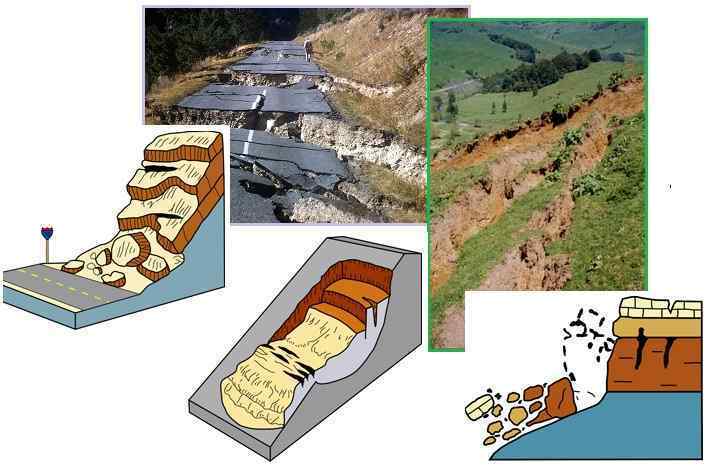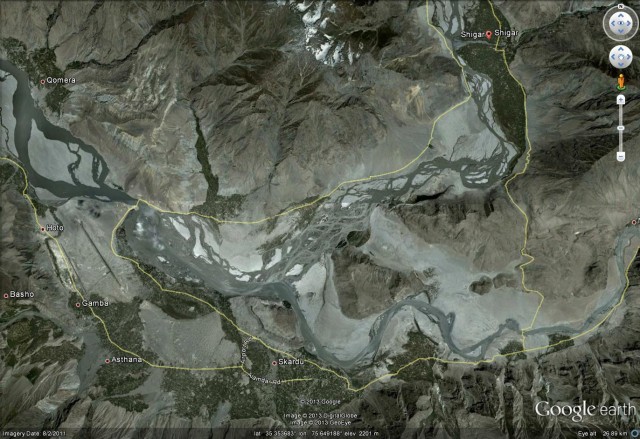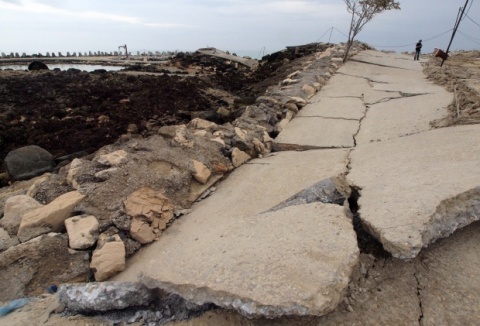

"The causes of landslides are not a mystery to mankind. Layers of rock and soil such that rain running along a clay or rock layer can create a slippery surface for the weight of the layers above it is a common cause. A rock jumble from previous mountain building, broken or fractured rock easily dislodged. We have stated that the earthquakes man experiences between the periodic passages of Planet X can be considered aftershocks from the last passage, and this is true of landslides also. Mountain building rumples the landscape, so the land is not flat but has steep ravines and hill sides. Older mountain ranges are recognized for their rounded or smoothed appearance, because of frequent landslides distributing the rubble.
"As we approach another passage, another Pole Shift, the pace of landslides has picked up. Why would this be? Plates under pressure will put pressure on regions that contain rumpled hillsides and deep ravines, as these give more readily than strictly flat land, thus act as a weak link. In addition, due to the wobble, the weather has gotten more extreme, with drought and deluge increasing in extremes. Dry ground, suddenly flooded with rainwater needing to seek its level as runoff, will create internal water slides between the rock and soil layers that constitute the rumpled hillsides. Is there an early warning system that mankind could use? The trembles that soil about to slide emits could be detected, yes. These are not earthquakes, and have their own frequency. "
Comment
-
Comment by Howard on January 28, 2013 at 4:09pm
-
At Least 7 Dead in Turkey Landslide (Jan 27)
At least seven people were killed late Sunday when a landslide invaded the pitch at an amateur football game in southeastern Turkey, engulfing players and spectators, local sources said.
Three others were injured and a fourth person went missing as sodden earth knocked over a wall at the football pitch in the city of Sirnak
Source
http://www.dailystar.com.lb/News/Middle-East/2013/Jan-28/204037-at-...
-
Comment by Howard on January 28, 2013 at 4:06pm
-
Landslide Strikes Philippines, Changes Course of River (Jan 27)
Dozens of families fled from their homes after a landslide hit a village in Maco, Compostela Valley on Sunday, authorities on Monday said.
Several houses were also washed away as a river in Mainit village “changed course” following the landslide past 7 p.m., according to Abel Dagoon, village chief.
At least 86 families were evacuated following the landslide, Senior Supt. Camilo Cascolan, Compostela Valley police chief, said.
A portion of a hill in Zone 1gave way, dumping large volume of rocks and earth to a river there, virtually diverting its course and flooding the community, said Dagoon.
“A crack (found after the 2008 landslide) might have collapsed already, causing this. We are still assessing the extent of damage (of properties). Fortunately, no one was hurt,” Dagoon told the Philippine Daily Inquirer by mobile phone.
He said a family composed of at least five people was briefly trapped after the swollen river changed course and flooded the community. They were eventually rescued.
The landslide on Sunday “dammed” the river, causing it to swell and flood the community, Raul Villocino, provincial disaster officer, said on Monday.
Villocino said Mainit was just across Masara, the village hit by the 2008 landslides.
Local officials had declared Masara a no-habitation area following the killer avalanches, but several former residents have reportedly returned and resettled there.
Dagoon said residents were evacuated early Sunday night as the downpour began, spending the night at the village hall, the village elementary school and at a chapel.
Compounding the residents’ problem was the lack of electricity in the area after last month’s typhoon had knocked out power lines there, the village official said.
Source
http://newsinfo.inquirer.net/348337/dozens-of-families-flee-from-comp
-
Comment by Howard on January 27, 2013 at 6:57pm
-
Landslides Wreak Havoc in Western Indonesia (Jan 27)
Rescuers found four more bodies Sunday, bringing the death toll to 18 in multiple landslides in western Indonesia, including five geothermal workers, officials said.
In Agam district, in West Sumatra province, 15 houses were buried beneath mud and rocks, killing seven.
The worst landslides happened in Tanjung Sani of Agam district in West Sumatra province, where 20 houses were buried when mud and rocks fell from surrounding hills at dawn on Sunday, killing 11 villagers, said disaster official Ade Edward.
Hundreds of terrified survivors fled their hillside homes for tents on safer ground, fearing more of the mountainside would collapse
In the neighbouring province of Jambi, a landslide occurred in a drilling field owned by a state-run energy company.
In a statement, PT Pertamina Geothermal Energy said that four of its workers had died, one remained missing and five had been injured. Sixty workers survived the landslide, the firm said.
"The workers were having dinner when the landslide suddenly occurred."
Sources
http://www.bbc.co.uk/news/world-asia-21218836
http://abcnews.go.com/International/wireStory/landslide-leaves-dead...
http://www.thesundaily.my/sites/default/files/thesun/Catalogue/INDO...
-
Comment by Kojima on January 26, 2013 at 11:43am
-
Landslide kills seven in Ecuador [NZweek; Souce:Xinhua Publish By Thomas Whittle Updated 25/01/2013]
QUITO, Jan. 24 — At least seven people were killed and 17 were injured by a landslide Thursday in Ecuador’s mining zone of Bella Rica in the southern province of Azuay, local authorities said.
Patricio Lopez, the mayor of Ponce Enriquez, told reporters the landslide occurred early in the day due to heavy rains, causing damage to two mines in the region.
The mayor said several miners may have been trapped in the mines and the death toll may rise over the next few hours.
Four homes have also been damaged and Ponce Enriquez has been left without electricity.
Rescue units are at the disaster site, which is located in a rural area accessible only on foot or by plane, local authorities said.
Ponce Enriquez has a population of more than 10,000 and most residents work in gold mining or agriculture.
The region was previously affected by landslides that killed several miners. Ten days ago, a Peruvian and an Ecuadorian died in another landslide in the same area.
-
Comment by lonne rey on January 25, 2013 at 12:10pm
-
25 January 2013
Another valley blocking landslide in northern Pakistan
Three years ago, In January 2010, a large landslide in Northern Pakistan caused enormous disruption. The landslide at Attabad, with which this blog was closely involved, remain unresolved, such that it affects the daily lives of thousands of people.
The ever-impressive Pamir Times, and various other newspapers in Pakistan, are now reporting another valley-blocking landslide in the same region, this time at Shigar in Skardu District. This area is shown on the map below – according to Google Earth Shigar is in the valley above Skardu:
-
Comment by lonne rey on October 16, 2012 at 10:23am
-
16 October 2012
An intriguing landslide from Bulgaria
The Sofia News Agency carried a report and picture yesterday of a landslide on the coast near to Kranevo on the Black Sea in Bulgaria. The image is shown below:
The commentary in the article states:
“The strip covered by the landslide is about 2 km, while the fishermen village near the shoreline is the most affected. The road leading to the water is completely destroyed with some of the fishermen trailers buried by the land mass. Eight people have been temporarily blocked, but have already managed to leave.
The Buildings and trees have been rotated to lean inland, suggesting a rotational landslide
-
Comment by Kojima on August 16, 2012 at 6:42am
-
Cameroon: Landslide in Akwaya, no Death [allAfrica]
The Director of Civil Protection Cabinet at the Ministry of Territorial Administration led a technical team alongside local officials in a visit to the site
The Governor of the South West Region, Bernard Okalia Bilai on Monday August 13 evening, convened a crisis meeting in his office premises, following a landslide that occurred in Kakpenyi quarter of Tinta village, Akwaya Subdivision. The major resolution of the impromptu meeting was the expression of government's determination to assist the victims. As such, measures are underway to provide the local population with food and other basic necessities, especially those injured as a result of the disaster.
Talking to the Divisional Officer of Akwaya, Austin Ayuni Sakah in Buea CT gathered the following. He explained that the quarter head of Kakpenyi in Tinta village sent an envoy to Akwaya Town on Thursday August 2. According to the informant, on Sunday July 29, the villagers heard unusual sounds like gun shots, accompanied by earth tremours. The situation continued till Wednesday August 1 afternoon, when they heard loud explosions from a nearby mountain followed by a heavy flow of rocks and soil down the slopes of the mountain. The descending rubble destroyed everything on its path, burying farms and trees, before ending up in a valley where two rivers (Ohongimbi and Kakpenyi) meet. The debris equally blocked the regular water flow of the two rivers and developing in a lake. The main road from Mamfe to Akwaya through Kakpenyi was completely cut off. As a result, all those using this stretch have to go through Atolo village. Some villagers working on their farms were wounded either from rocks flowing from the mountain or in the course of fleeing from the danger. But no human loss has been registered. The main crops destroyed include cocoa, palms, kola nuts, bush mango, banana, pineapples, and beehives, amongst others.
The Divisional Officer and his close collaborators visited the site the next day, Friday August 3. The only access is by foot, summing to about three hours trek. A meeting was convened in the quarter hall to probe into the matter. As a result, the identification of 21 persons whose farms were destroyed was done as well as that of 23 injured persons needing medical attention. It was also revealed that the explosions were frequent and mostly provoked by rainfall leading to heavy landslides. The affected area is about 500 metres wide and one kilometer long while the air is heavily polluted with the stench of gaz. Kakpenyi has a population of 267 inhabitants with 88 houses and 48 house heads. Some of the frightened population has moved to nearby villages for their safety.
At press time, the Director of Civil Protection in the Ministry of Territorial Administration and Decentralisation, Nnana Jean Pierre led a technical team to the site on Saturday August 11. An evaluation of the scene revealed it was a landslide and not an eruption as believed by many. Jean Pierre Nnana equally offered financial assistance to the farmers who had lost their farms; and a medical team was stationed in Kakpenyi for at least three weeks to attend to the patients, while measures are underway to ensure the population's safety from subsequent crises. Meanwhile the population has been urged to remain vigilant and avoid treading on the affected areas, till further notice.
-
Comment by Kojima on August 16, 2012 at 2:31am
-
Thank you, Robyn Appleton.
I'm glad that we have the landslides blog, and I'm going to post the landslide incidents as a comment from now on.
---------------------------------------------------
* Landslide deaths much higher than thought - study [swissinfo.ch]
* Landslide deaths much higher than thought – study [euronews]
LONDON (Reuters) – Landslides killed more than 32,000 people across the world from 2004 to 2010 – up to 10 times more than previously thought, the first detailed study of the disasters showed on Thursday.
The new data on the scale of the problem should force governments to rethink how they dealt with the slides which have left a trail of destruction from China to Central and South America, researchers said.
“Landslides are a global hazard requiring a major change in perception and policy,” said David Petley, lead researcher on the study at Britain’s University of Durham.
“There are things that we can do to manage and mitigate landslide risks such as controlling land use, proactive forest management and guiding development away from vulnerable areas.”
Information, collected in a database in Durham and published in the journal Geology on Thursday, showed 32,322 people died in 2,620 landslides across the world from 2004 to 2010.
Previous estimates ranged from 3,000 to 7,000 deaths over the same period, said the researchers.
The sharp difference in the estimates was probably due to the introduction of better data collection methods, they added.
Last month, floods and landslides killed more than 100 people in southern Russia after two month’s average rainfall fell in a few hours.
In June, about 30 people died and more than 100 went missing after a landslide in eastern Uganda.
Landslides are mass movements of rock, debris and soil, often caused by earthquakes, heavy rainfall and human activity such as timber harvesting or mining.
The Durham Fatal Landslide Database identified hotspots – among them the south-west coast of India, Sri Lanka, the southern and eastern coasts of China, the central Caribbean islands, Indonesia and mountains from Mexico to Chile.
The most fatal landslides were recorded in May to October and the most common trigger was monsoon rains, the study showed.
The Durham researchers said there was a good chance they had actually underestimated the number of landslide deaths because they had had to leave out a number of fatalities recorded following earthquakes.
It was often unclear whether people had been killed by a landslide or other after effects of a quake, they added.
Scientists have said landslides could become more common, because of rising populations, more intense rainfall and the clearing of forests.
Climate change increased the odds for the kind of extreme weather sometimes linked to landslides and other disasters, a report said last month.
(Editing by Andrew Heavens)
---------------------------------------------------
# They identified hotspots, which is around the area of "7 of 10", and we know the real cause.
- ‹ Previous
- 1
- …
- 75
- 76
- 77
- Next ›
SEARCH PS Ning or Zetatalk
This free script provided by
JavaScript Kit
Donate
© 2025 Created by 0nin2migqvl32.
Powered by
![]()


You need to be a member of Earth Changes and the Pole Shift to add comments!
Join Earth Changes and the Pole Shift